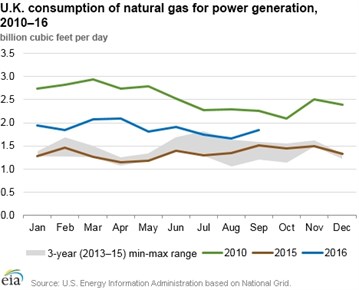EIA: UK 2016 natural gas usage exceeds three-year average

Graphic courtesy of the US Energy Information Administration.
The Carrington gas-fired power plant in Manchester, England began commercial operations on September 26, 2016. This 880-MW facility is the UK’s first gas-fired power plant commissioned in the past three years. In 2016, natural gas consumption for power generation (power burn) has increased considerably in the UK as more coal-fired power plants have been retired. Power burn increased by 43% in the first nine months of 2016 compared with the same period last year, and was 37% higher than the three-year (2013–15) average. Coal generation accounted for 23% of the total electricity generated in the UK in 2015. This year through July (the most recent data), the coal share of electricity generation decreased to 10%. At the same time, the share of natural gas-fired generation increased to 40% of the total electricity generated in the first seven months of 2016, its largest share since 2010, while nuclear accounted for 20%, and renewable generation and electricity imports accounted for the remaining 30%.
In 2015, approximately 12 GW of coal- and oil-fired electric generation capacity was retired, largely to comply with the EU Large Combustion Plants Directive and the government's general policy shift toward greener energy. These retirements led to a 24% decline in coal-fired generation. Additionally, in 2015, the increase in the carbon price floor (CPF), which applies an additional tax on power sector carbon emissions, increased operational costs of coal-fired power plants. The CPF, initially introduced in April 2013 at $12.40 per ton of carbon dioxide, doubled in April 2015 to $23.45 per ton of carbon dioxide, increasing the cost of coal-fired generation as compared to 2014.
UK natural gas power burn has generally increased over the past two decades, and peaked in 2010. However, power burn declined 47% from 2010 to 2012, following a significant increase in natural gas prices from US $6.56/MMBtu (annual average) in 2010 to US $9.49/MMBtu over the same period in 2012. Natural gas-fired generation remained at about the same level in 2012–15, while the combined share of renewable generation (particularly wind), and net imports increased from 16% to 30% over the same period.
Falling natural gas prices in 2016 made natural gas-fired power plants decidedly more competitive than coal-fired power plants. In May 2016, UK electricity generated from coal fell to zero on several days for the first time in 100 years. Although coal generation is expected to continue to decline with more power plant closures in the next five years, the recent approval of the 3.3 GW Hinkley Point C nuclear power plant and growth in renewable generation will affect the growth in natural gas-fired electricity generation over the long term.

- ExxonMobil halts 1-Bft3d blue hydrogen project in Texas
- Aramco and Yokogawa commission multiple autonomous control AI agents at Fadhili gas plant
- Ukraine will resume gas imports via Transbalkan route in November
- Mitsubishi to inject $260 MM into Brunei LNG project
- Freeport LNG (U.S.) on track to take in more natgas on Thursday after unit outage



Comments